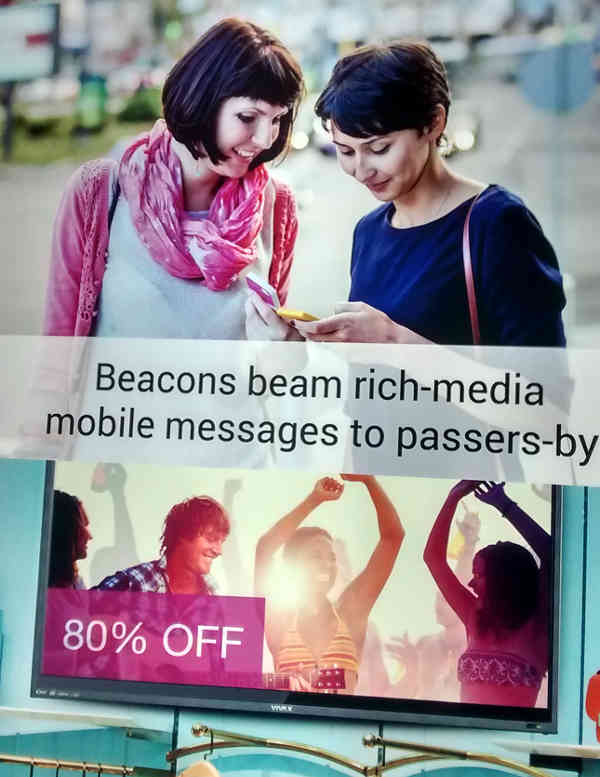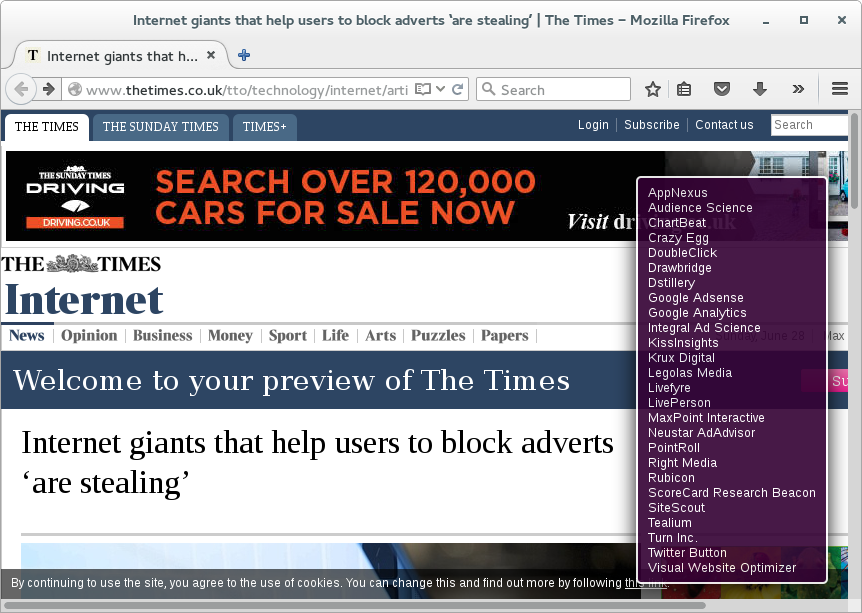Ad blocking: why now?
Users say that they're blocking ads because of the annoyance. But that can't be the whole reason that ad blocking is just recently starting to catch on. The reasons for web ad blocking have been there since the beginning. Distracting blinky ads, slow page load times, security concerns, the whole mess.
The ease of use of ad blocking has also been roughly constant for more than a decade. For a long time, it's been easy to find an ad blocker that is easy to install and use.
So what changed? Why did the first generation of easy, effective ad blockers—Internet Junkbuster, WebWasher, AdSubtract, and others—completely fail to catch on, while today ad blocking is a thing?
The red line,
retargeting
, is a query for a form of targeted advertising that is easily visible to users—ads that users can seefollowing them around.
The blue line is a query for
how to block ads
. Users looking for a solution.
Why does the blue line start to take off only after the red line? Web ads were just as annoying before users started to see how they were targeted. What is it about targeted ads that changed the decision to block? Why was the 2010 What They Know series in the Wall Street Journal such a big deal?
Until the Thought Leaders of Marketing can come up with an answer to that, all they can do is get their pearls re-strung with Spectra®, to handle the outbreak of extreme pearl-clutching.
Maybe we should take a step back. Maybe the problem is: Do we really understand what the basic bargain behind advertising is? Why do people put up with advertising in some media but block it in others?
Gavin Dunaway at AdMonsters writes,
The transaction between most Internet content providers and users is something I’ve always referred to as the “unspoken handshake” – users pay for their content consumption with personal data as well as by allowing advertisers the opportunity to reach them.
That's one kind of exchange. It's the lead generation bargain. Fill out this form to WATCH OUR FREE WEBINAR! People choose to reveal personal info all the time, every time they enter a sweepstakes or swipe a supermarket loyalty card.
But are users passively choosing to share data with unknown third parties (quick, name three companies that ran trackers on the last news story you read, and what they do with your data)? Survey says....no.
And is the lead generation bargain the only bargain that matters in advertising?
Lead generation can send a special offer to buy a product for a lower price...

...but can it build a brand that people will be happy to pay a higher price for?
Clearly the lead generation bargain has not been the point of high-value old-school ad media such as TV, radio, and print. Nobody gives up any personal data to watch Knight Rider on broadcast TV, or buy a copy of the newspaper out of a vending machine. But that impersonal advertising is where the money is. Something must be making it valuable.
The bargain that matters in advertising's big leagues is the exchange of signal for a user's attention. An ad can be a public, credible, costly display of the advertiser's intentions. When an ad fails to send a signal, as is the case when it's targeted to a user, the ad doesn't hold up its end of the signal-for-attention bargain, and users start looking for an opportunity to block it.
Which is where all those opinion pieces about the problem of ad blocking are only getting half the story. One way to look at the problems is to accuse ad blocker users of violating a reciprocity norm, by entering into an implied lead generation bargain and then failing to hold up their end. But the other, more valuable deal—the signal-for-attention bargain—is the one that advertisers broke first, and set the problem off.
How to hold up both bargains?
One important direction is to make the lead generation bargain explicit, not sneaky. Instead of using malware-like data gathering techniques, make it easier for users to control how they share their info. Project VRM is working on that.
The other half, and the part that the Aloodo project is all about, is restoring the signal-for-attention bargain. Fixing signaling, by enabling tracking protection, makes the web into a more trustworthy medium, and also helps with the problem of ad fraud. Instead of point solutions to blocking and fraud, tracking protection both
cuts off the data leakage that drives fraud and
prevents the unease-inducing cross-site tracking that motivates users to block ads.
A unified approach to blocking and fraud is better than taking on either one by itself. You can't even measure blocking accurately without a good measurement of fraud. And trying to reduce the amount of fraud on its own is likely to drive blocking up, while trying to reduce blocking is likely to create new opportunities for fraud.
We should have an expensive conference about this!
Sorry, no conference. This is not a collective action problem, and this is not a conference-convening solution. It's an opportunity to quietly help redesign the way advertising works on the web, whether you have a brand site, an original content site, or a blog.
The independent sites and brands that
act first to help get their users running
tracking protection in place of a general ad
blocker will be the
first to be able to signal effectively. Building
brands that pass Bob Hoffman's refrigerator
test
will be the bonus for beating blocking and fraud.
If you're a Big Data fan, and if you think that throwing more data-collection technology at the problem will solve it, then this is not for you. Otherwise, here are a few next steps for anyone with a web site. We promise that it will always be just as easy as adding a social button or analytics script. Try it on a blog or low-traffic page and see how it goes.
Don Marti · #